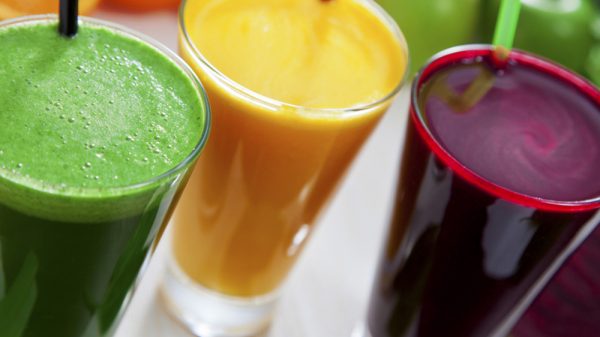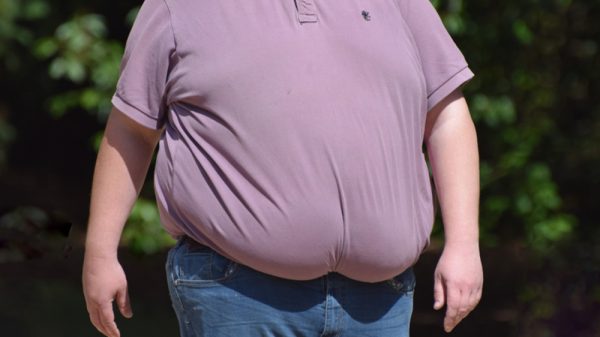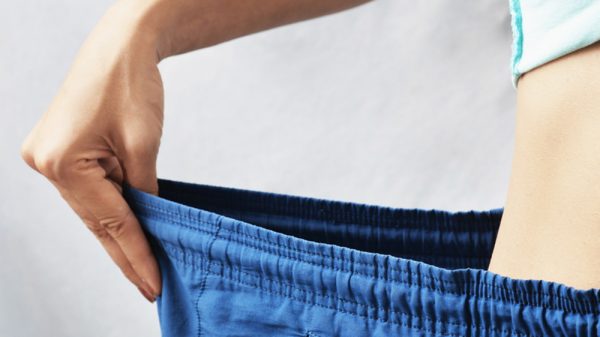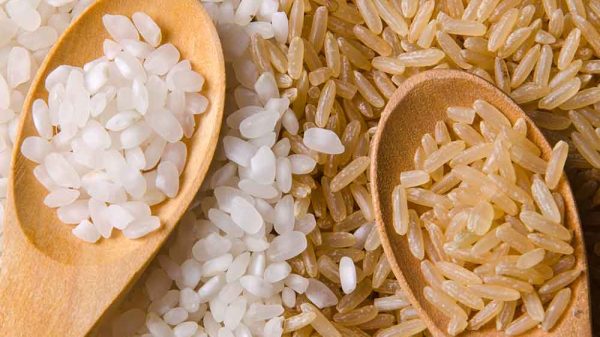Carb cycling has become popular in the fitness world as a way to get great results without deprivation. Incorporating carb cycling into a healthy diet and exercise routine can have benefits for fat loss, in turn supporting the reversal of conditions like fatty liver disease and metabolic syndrome. Let’s go through everything you need to know about carb cycling.
Carb Cycling in a Nutshell
What is carb cycling, anyways? Carb cycling describes the pattern of eating higher or lower amounts of carbs on different days, based on your needs. Typically, the high-carb days and low-carb days alternate. Higher-carb days tend to coincide with workouts, while lower-carb days are rest days. However, depending on your goals, some fitness professionals may recommend low-carbohydrate meals on training days.
You may be familiar with the term “carb-loading,” which describes eating large quantities of carbohydrates before a period of intense physical exertion like heavy weight-lifting or running a marathon. During high-carb days, you are essentially carb-loading. On rest days, you are lowering your carb intake since your body is exerting less energy and therefore doesn’t need as many carbs.
Of the three macronutrients, carbohydrates rapidly provide the body with energy, which is why we “carb-load” instead of “protein-load” or “fat-load.” Carbohydrates are broken down into glucose molecules that muscle tissue, cardiovascular tissue, and brain tissue require to perform. Glucose enters the bloodstream for immediate uptake by cells. Glucose molecules are shuttled to the mitochondria within cells where they are used to make adenosine triphosphate (ATP), the primary form of useable energy in the body. Leftover glucose is stored as glycogen in the liver.
Health Benefits of Carb Cycling
Carb-cycling makes the biggest impact on weight loss if you lead a very active lifestyle. Fueling your body with carbohydrates on days that you exercise ensures that your body is equipped to exert energy during a workout.
Eating lots of carbs also revs your metabolism and helps prevent a stalling metabolism that often accompanies restrictive diets. Plus, if you’re at a weight-loss plateau, jump-starting your metabolism with more carbohydrates may be just what you need to continue losing weight and ultimately reach a healthy body weight. Following a carb cycling diet may maximize your body’s fat-burning capacity, resulting in a better body composition that is lower in fat and higher in muscle mass.
Eating lower amounts on carbohydrates on rest days allows the body to focus on utilizing healthy fats and essential amino acids from protein to build muscle and repair tissue. Your kick-started metabolism will continue burning through your low-carb days, which helps your body burn fat more readily.
Though there is limited research on the efficacy of carb cycling, there is consensus in the fitness world that carb cycling seems to cut body fat while boosting the metabolism and increasing energy. Athletes in wrestling and bodybuilding have relied on carb cycling to maximize muscle mass while minimizing body fat.
Optimizing your workout performance and increasing your metabolic rate can help you lose weight while maintaining muscle. Both fat loss and muscle growth are critical to improving cardiovascular health, facilitating weight loss, soothing systemic inflammation, and improving indicators of fatty liver disease and metabolic syndrome.
Importance of Eating Healthy Carbs
Even if you’re following a meal plan that cycles through different amounts of carbohydrates, it is still crucial to choose your carbohydrates wisely.
Not all carbohydrates are the same. Processed carbohydrates and added sugars are the bad kinds of carbohydrates and are generally referred to as simple carbs. Carbohydrates from whole foods are categorized as good carbohydrates and are generally referred to as complex carbs.
Simple Carbs (Bad Carbs)
Examples of simple carbohydrates include white bread, white pasta, cake, cookies, and candy. When you eat these foods, the body quickly converts the carbohydrate molecules into glucose molecules that enter the bloodstream at a rapid rate. Blood sugar levels rise sharply, and the pancreas releases insulin to notify your cells to collect the glucose from the blood to use for energy. As a result, your body is unable to respond quickly enough to clear all of the sugar from your bloodstream, leaving some to be converted to fat stores.
Eating simple carbs may give you a temporary boost of energy but will ultimately sabotage your goals to lose weight and improve metabolic syndrome and fatty liver disease. Consuming large amounts of simple carbs over time is hard on your pancreas and wreaks havoc on your metabolic health. Long-term consumption of simple carbs may lead to insulin resistance, prediabetes, and eventually the development of type 2 diabetes.
Complex Carbs (Good Carbs)
Instead of simple carbohydrates, go for complex carbohydrates found in whole grains, fruits, veggies, and beans. Complex carbs are digested much more slowly and steadily release glucose into the bloodstream. As a result, insulin is able to readily respond to the presence of glucose in your bloodstream, and your cells utilize the glucose for energy.
Complex carbohydrates are also jam-packed with fiber, antioxidants, vitamins, and minerals that promote cardiovascular health and brain health as well as improvements in fatty liver disease and metabolic syndrome.
Keep in mind that fruit sugar, when eaten as part of the whole fruit, is also a complex carbohydrate since it is paired with dietary fiber. Digesting sugar when paired with soluble and insoluble fiber drastically slows the rate of digestion, which allows sugar to be released into the bloodstream at a steady rate. A slow release of sugar prevents blood sugar spikes and instead provides sustainable energy to all organ systems.
Pros and Cons of Carb Cycling
Carb cycling may not be for everyone, and it’s important to consult your doctor, a registered dietician, or nutritionist to evaluate whether carb cycling is good for your individual biochemistry and health conditions. Make sure you weigh the pros and cons of carb cycling and assess whether carb cycling works for your specific needs.
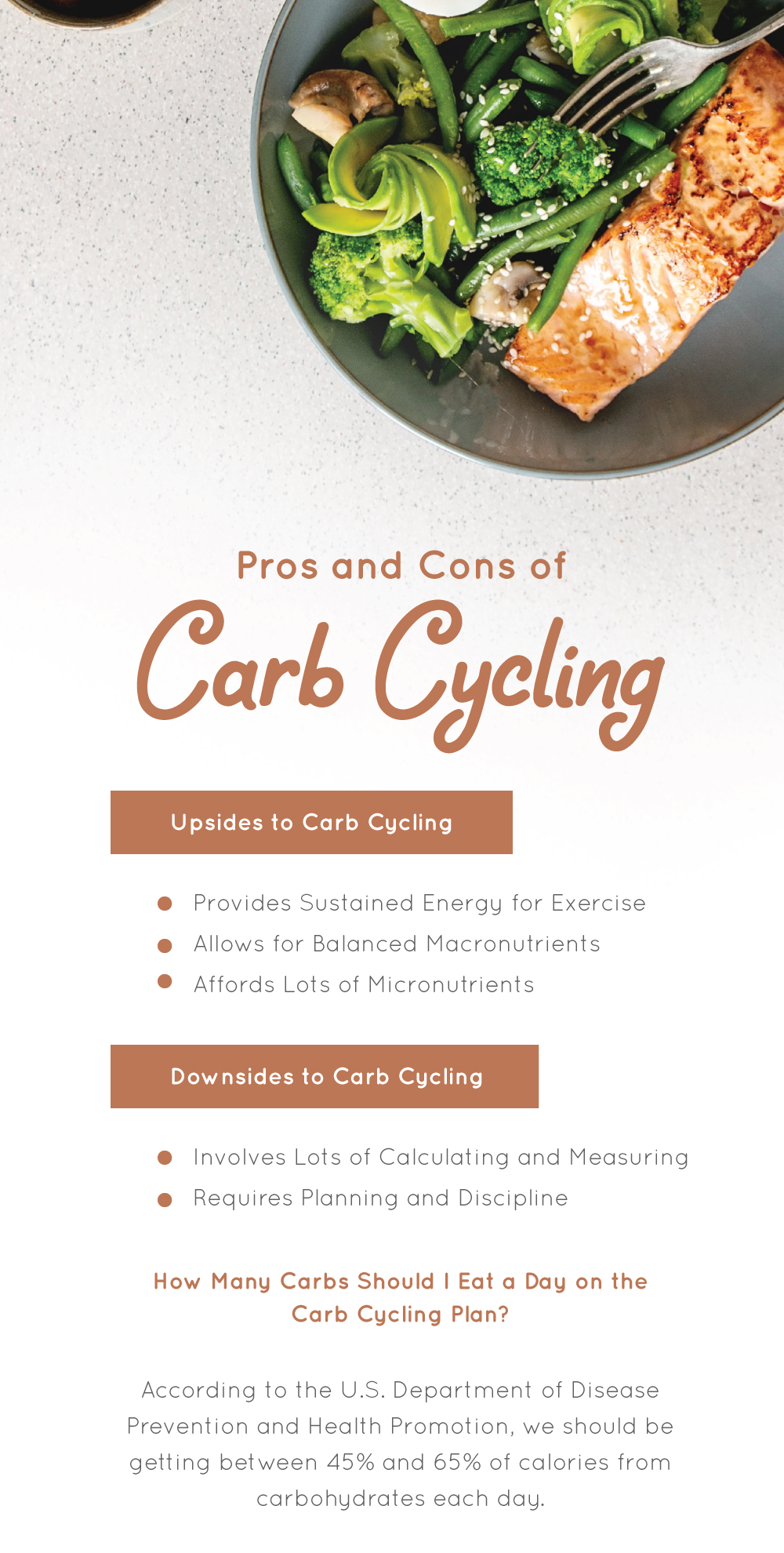
Upsides to Carb Cycling
1. Provides Sustained Energy for Exercise
Carb cycling is based on the fact that carbohydrates are a necessary nutrient for optimal performance. Carb cycling can be an effective way to get the most out of your workouts without deprivation. When you fuel your workouts with sufficient carbohydrate intake, you will likely feel energized and may be more able to lift weights and test your cardiovascular endurance. You will be less likely to become fatigued during a workout or even lose weight without exercise.
2. Allows for Balanced Macronutrients
Alternating your carb consumption is superior to a sustained low-carb diet, which can lead to an imbalance with other macronutrients. Too much fat and protein without adequate carbohydrates can lead to fatigue and digestive issues. Cycling through low-carb days and high-carb days results in an optimal balance of macronutrients that your body can utilize for energy and repair.
3. Affords Lots of Micronutrients
High-carb days that are filled with healthy carbohydrates allow you to incorporate extra fiber, antioxidants, vitamins, and minerals into your diet. Complex carbohydrates found in whole foods are naturally paired with an array of health-promoting nutrients like fiber, vitamin C, vitamin E, manganese, and polyphenols with antioxidant activity. These micronutrients decrease systemic inflammation and facilitate muscle and tissue repair following a workout.
Downsides to Carb Cycling
1. Involves Lots of Calculating and Measuring
Constantly changing your carbohydrate intake requires you to also adapt the amount of protein and fat you’re eating as well. Counting macros is a helpful strategy to correctly carb cycle and allows you to balance your carbs, protein, and fats based on your activity levels and goals. However, counting and calculating grams of macronutrients can be inconvenient and time-consuming.
2. Requires Planning and Discipline
When you are alternating your daily carbohydrate intake, it is often necessary to plan your meals ahead of time. This may mean creating a meal plan that allows you to complete grocery shopping and meal prepping ahead of time. Planning your meals in advance allows you to properly measure your protein intake, fat intake, and carbohydrate intake to maximize results. However, consistency over time makes calculating and counting more second-nature and easier to keep track of.
It can be easy to interpret high-carbohydrate days as free-for-alls that lead to eating excessive amounts of carbohydrates from chips, bread, sugary drinks, and baked goods. Make sure you base your high-carb days on whole foods and don’t go overboard.
How Many Carbs Should I Eat a Day on the Carb Cycling Plan?
The number of grams of carbohydrates you consume will vary from person to person. According to the U.S. Department of Disease Prevention and Health Promotion, we should be getting between 45% and 65% of calories from carbohydrates each day. (1)
Maybe this means that on a high-carb day, you aim for getting closer to 65% of calories from carbohydrates, and on low-carb days, you aim for getting at most 45% of your calories from carbohydrates.
To calculate exactly how many grams of carbohydrates you need, you must take into account your daily calorie requirement, activity levels, and any other circumstances that influence your food intake. Counting macros is a helpful strategy for determining how many grams of carbs, protein, and fat you should be consuming.
It’s also important to keep in mind that a high-carb day is not the same as a cheat day. High-carb simply means you are allocating the calories from macronutrients in different proportions. On high-carb days, more calories are coming from carbohydrates than from protein or fat. However, if you are engaging in particularly strenuous activity on certain days, it may be necessary to increase your calorie intake accordingly.
Before you start to carb cycle, talk with a registered dietician about how to adapt carb cycling to your specific needs.
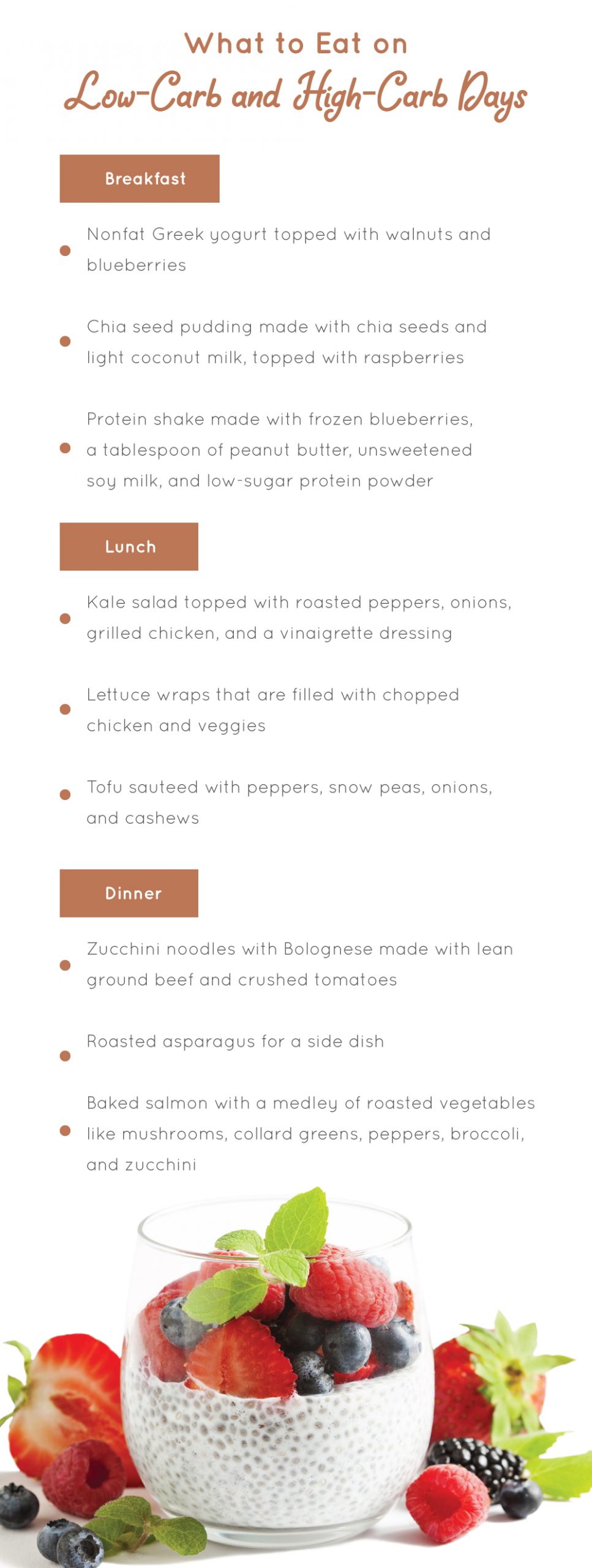
What to Eat on Low-Carb and High-Carb Days
If you’re following a carb cycling meal plan, it’s helpful to have some meal ideas on hand for low-carb and high-carb days.
Low-Carb Meal Ideas
- Breakfast. For breakfast, a low-carb option is nonfat Greek yogurt topped with walnuts and blueberries. Another idea for breakfast is chia seed pudding made with chia seeds and light coconut milk, topped with raspberries. If you’re strapped for time, a protein shake made with frozen blueberries, a tablespoon of peanut butter, unsweetened soy milk, and low-sugar protein powder can be the perfect high-protein, low-carb energy fix you need to get your morning going.
- Lunch. A low-carb lunch option is kale salad topped with roasted peppers, onions, grilled chicken, and a vinaigrette dressing. Another lunch option is making lettuce wraps that are filled with chopped chicken and veggies. If you’re looking for a hot meal, tofu sauteed with peppers, snow peas, onions, and cashews is a tasty, protein-packed option for a low-carb lunch.
- Dinner. For dinner, try zucchini noodles with Bolognese made with lean ground beef and crushed tomatoes. Add a side of roasted asparagus for a meal that is filled with vegetables and high-quality protein. Another option for a filling, low-carb dinner is a serving of baked salmon with a medley of roasted vegetables like mushrooms, collard greens, peppers, broccoli, and zucchini. For a vegetarian dish that is still high in protein, replace meat with tofu. Like meat, tofu contains nearly zero carbs and is a complete protein source that contains all essential amino acids that support brain function, muscle synthesis, and liver health. Try using tofu in vegetable stir-fry dishes seasoned with curry, turmeric, and ginger.
High-Carb Meal Ideas
- Breakfast. To prepare breakfast for your higher-carb days, prepare two slices of whole-grain toast. Top one with avocado slices, red pepper flakes, salt, and pepper. Top the other slice with an egg and a sprinkle of low-fat cheese. A bowl of oatmeal topped with banana and walnuts is another option for a high-carb breakfast.
- Lunch. A high-carb lunch may include a stir-fry with brown rice, grilled squash, sautéed kale, chickpeas, and a drizzle of olive oil. Another option for a high-carb lunch is a whole-wheat wrap filled with lettuce, tomato, cucumber, grilled chicken, and pesto.
- Dinner. For dinner, try creating a burrito bowl. Top a serving of quinoa with roasted sweet potato cubes, black beans, shredded lettuce, sautéed bell peppers, and onions. Add flavor with your favorite hot sauce, salsa, and guacamole. Top with fresh chopped cilantro and a drizzle of fresh lime juice. A pasta dish made with whole-grain wheat or chickpea pasta is another excellent way to get your fill of healthy carbs on a high-carb day. Top the pasta with lemon, garlic, and red pepper flakes, and serve with sautéed shrimp for extra protein.
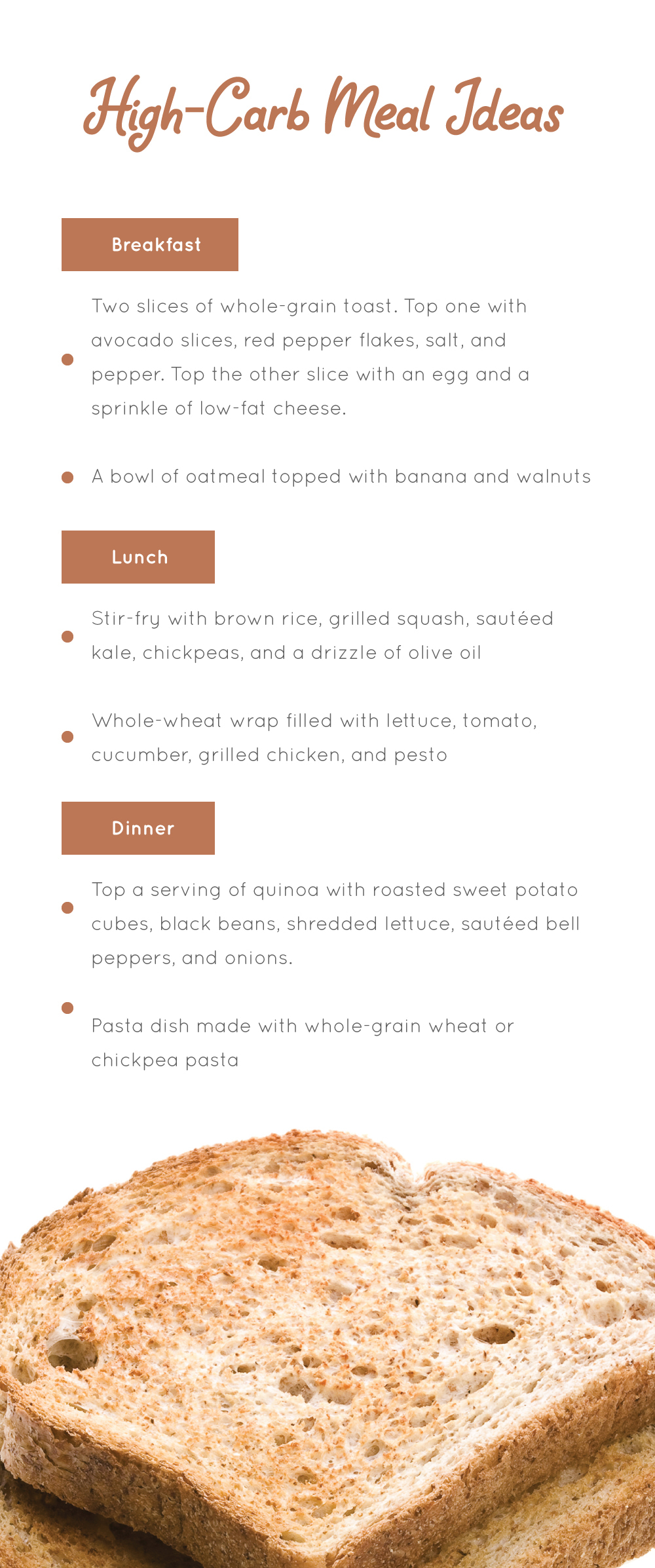
Snacks
Regardless of whether you’re on a high-carb day or low-carb day in your carb cycling plan, fresh fruit is an excellent snack option that’s packed with fiber, vitamins, minerals, and antioxidants. Low-carb doesn’t mean no-carb, so it’s ok to have some healthy carbs incorporated throughout your day. Delicious, nutrient-packed fruits include blueberries, blackberries, strawberries, bananas, apples, oranges, pomegranate, mango, watermelon, kiwi, pineapple, papaya, cherries, and grapes.
Conclusion
If you’re looking to get the benefits of a low-carb diet with additional flexibility and no deprivation, carb cycling may be for you. Alternating high-carb and low-carb days may jump-start fat loss and fuel your workouts while promoting metabolic health and supporting the reversal of fatty liver disease.
References:
(1) https://health.gov/dietaryguidelines/2015/guidelines/appendix-7/


